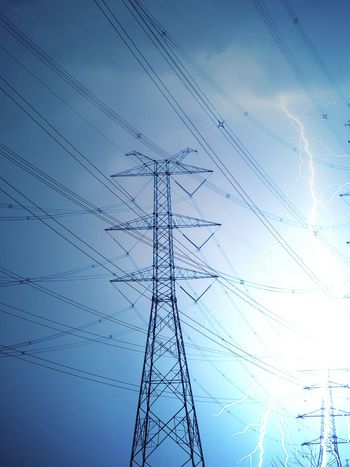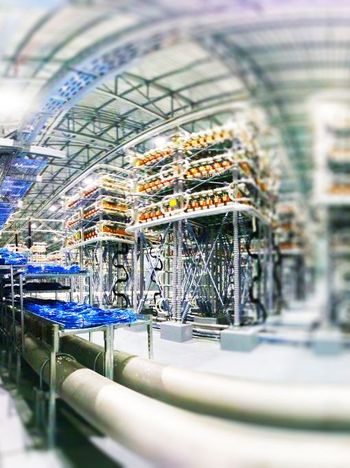Substations and Electrical installations
By Koji Kawakita, Chair & Samuel Nguefeu, Secretary
Introduction
2020 was a challenging year for CIGRE and SC B3 and people all over the world. People were restricted from moving, unable to communicate in person, and forced to live anxious lives in the fight against invisible enemies.
Online meetings and conferences have become the only means of activity for SC B3 to counter this. We realised the importance of face-to-face communication and interaction between members again.
Despite this situation, it was an active year for SC B3. 2020 e-Session was successful in that B3 Group Discussion Meeting was marked with approximately 400 registrations and over 200 attendees with 49 paper presentations, including 3 Young Member showcase presentation. The session questions and comments counted 200 (125 online plus 75 in the KMS space). 5 technical brochures were published in 2020. It was the highest number recorded in the SC B3 history.
Substations continue to play a key role as nodes within electrical networks, providing the capability for the network to deliver safe, reliable energy with high availability.
To support the realisation of a sustainable society, substations’ research & development continues to make advances in new technologies and applications that offer substation owners and operators the flexibility, security and stability they need to continue to expand their systems in an efficient and environmentally friendly manner.
However, transmission substations remain essential for bulk power transmissions such as interconnecting load regions, large generation resources and energy storage, and offshore supplies.
The focus area for SC B3 is the coordinated design and operation between transmission and distribution to facilitate more flexible and active distribution networks. Facilitating this connectivity to support the integration of decentralised renewable energy resources, energy storage, and more active customer participation with bilateral power flow is increasingly essential. At the same time, these challenges need to consider asset management practices that can identify the best use of installed assets by optimising their functionality, interventions and lifetime.
The challenges mentioned above have resulted in several new initiatives:
- Dealing with the increased impact on substation design due to integration of renewable energy resources, energy storage systems and other installations.
- Mitigating environmental, health, safety and security impacts, including the reduction of Green House Gas emission and the substation carbon footprint
- Substation design, operation and maintenance resilience against natural disaster, threat (terrorism, epidemic, physical/cyber, etc.)
- Optimising substation asset intervention (retrofit, uprating, upgrading, renewal, extensions).
- Increased substation operational efficiency and availability.
- Integration of intelligence for digitalisation.
- New set of skills for new technologies, knowledge transfer and high standards of education in engineering skills.
These solutions aim to include the needs of developing communities and emerging economies, as well as those of established industrialised countries.
The SC B3 mission is to:
- Facilitate and promote the progress of engineering and the international exchange of information and knowledge in the field of substations and electrical installations.
- Add value to this information and knowledge by synthesising state-of-the-art best practice and developing recommendations and guidance.
SC B3 has a keen focus on the rapid changes in the utility industry, with an eye on design concepts and new environmentally green and sustainable materials. The goal is to address existing technical needs while developing a bridge to the future.
Strategy and direction
The SC B3 strategy and direction are continuously reviewed to ensure it meets our stakeholders' needs. Our current strategic plan covers the period from 2018 to 2028. The main technical directions are the following.
T1. New substation concepts
Development of new concepts including bus arrangements, hybrid solutions, new applications and functions. The impact from distributed generation and power flow control systems including specification of corresponding design/layout criteria for substations constituting integral parts of totally optimised networks. Reduction of carbon footprint impact through new technologies.
T2. Substation ownership issues
Organisational aspects including human resource and training needs, in-service support, software management including quality control and maintenance. Management of assets including environmental, health, safety, and security.
T3. Life cycle management
Monitoring in-service experience, substation condition assessment, aspects of maintenance outsourcing, short- and long-term needs, opportunities for cost reduction, spare parts. Increased utilisation (life extension, upgrading, and dynamic loading), refurbishment /renovation concepts, and investment strategies, principles for combining existing and new equipment, accounting for specific demands from network-reliability and customer demand-side points of view.
T4. Integration of intelligence for digitalisation on substations
New digital technologies (Artificial Intelligence, Internet of Things, 3-Dimensional technology etc.) and applications to be used in all aspects of substation design, operation and management. Identify the opportunities offered from the increased use of advanced information and communication technologies.
A key focus is considering how to improve the opportunities for younger member participation in connection with CIGRE “Next Generation Network” as well as increasing the involvement of women experts in our activities coordinating with the “Women in Engineering” initiative.
Membership and Experts
Our work continues through the support of our National Committee representatives, substation specialists and experts from across the globe. We are working with country representatives, 24 regular members plus an additional 4 members representing electricity sectors other than transmission and 17 observer members. Strategic/Customer/Tutorial advisory group and Quality Assurance team also support our work in their respective roles.

Figure 1 - Study Committee B3 Organisational Structure
More than 380 experts from across the globe are involved in SC B3 activities and working groups as indicated in Figure 2.
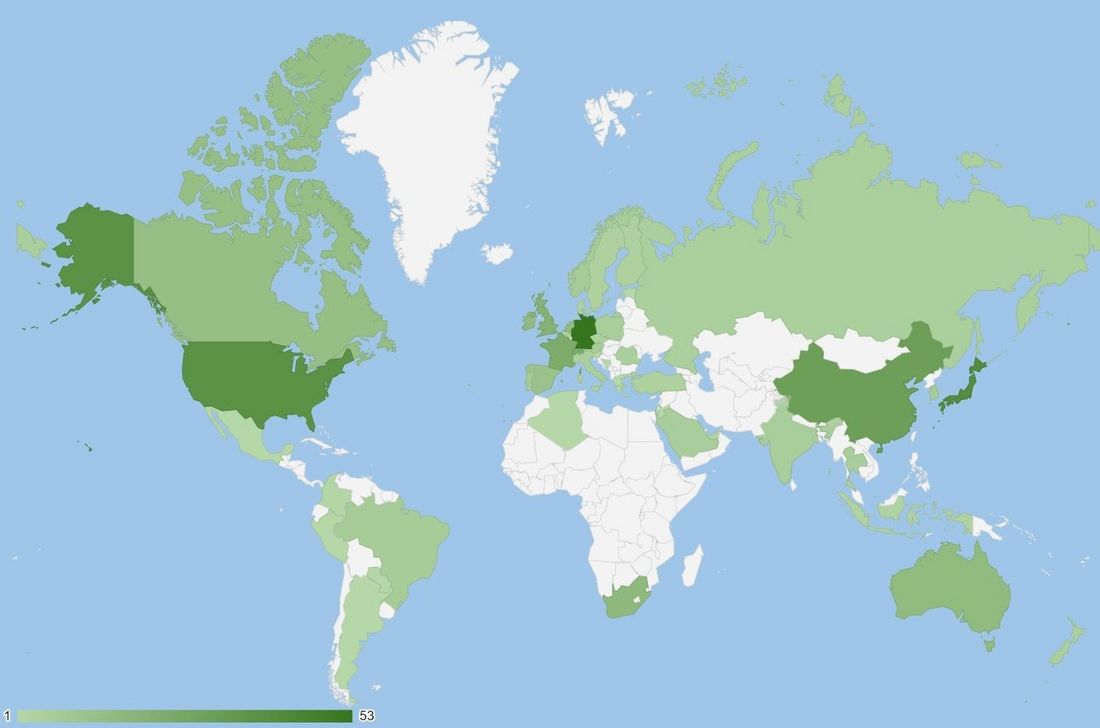
Figure 2 - SC B3 Members and Experts represent the global community
Working Groups
The Working Groups (WGs) are the “engine room” of CIGRE technical work. Our WG are arranged in 4 key work areas, which facilitate how we organise our work, bringing together our global experts to focus their understanding to achieve our objectives. Area advisors coordinate and align working group activities to the SC B3 Strategy, with responsibilities to support SC B3 Chairperson. Young members are particularly encouraged to join WGs as supporting or active members.
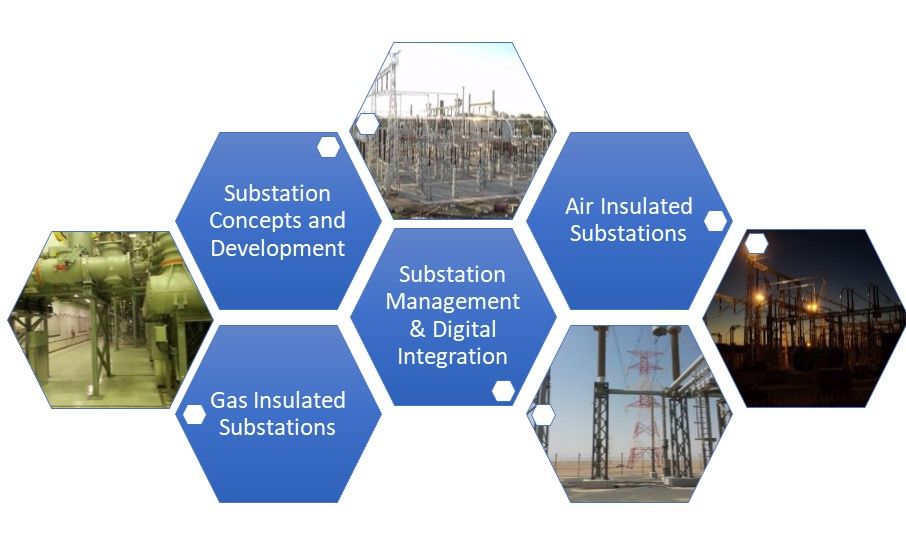
Figure 3 - SC B3 work areas
The total number of active WG in SC B3 at the end of April 2021 is 14 Working Groups plus 5 Joint Working Groups (2 B3 led and 3 led by other SC) and 1 Green Book project.
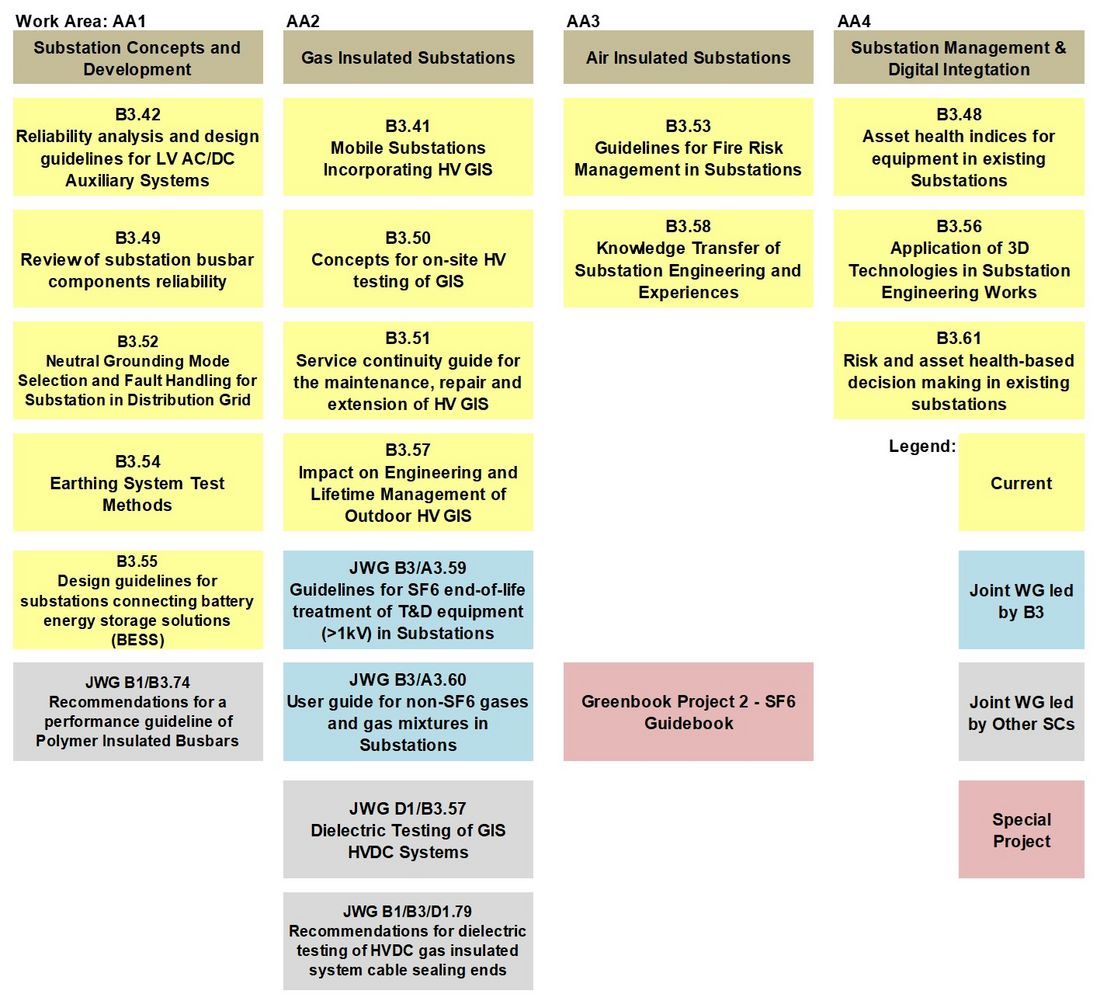
Figure 4 – Study Committee B3 WGs
New WGs that were recently approved include:
- JWG B3/A3.59 - Guidelines for SF6 end-of-life treatment of T&D equipment (>1kV) in Substations
- JWG B3/A3.60 - User guide for non-SF6 gases and gas mixtures in Substations
- WG B3.61 - Risk and asset health-based decision making in existing substations
Many new topics are currently under discussion such as:
- Guidelines for Managing Black Start Resilience in Substations
- Experience in offshore substation operation and maintenance
- LPIT (Low Power Instrument Transformers) with digital interfaces for revenue metering
- Substation resilience: physical & cybersecurity
WGs are not possible without support from national committees in nominating suitable experts and specialists to participate in the work. We value and encourage all national committees to review each new terms of reference and to consider appropriate experts available to support them.

CIGRE active Working Groups / Call for experts
Publications
5 Technical Brochures (TBs) were published in 2020 for Study Committee B3 including:
It was the highest number recorded in SC B3 history.
Also, a new Technical Brochure (TB) was published recently:
Summary available in this edition of ELECTRA
The following Working Group brochures are expected to be completed in 2021:
- B3.41 - Mobile Substations Incorporating HV GIS – Design Aspects
- B3.48 - Asset Health Indices for Equipment in existing Substations
- B3.49 - Review of Substation Busbar Components Reliability
- B3.53 - Guidelines for Fire Risk Management in Substations
- Green Book: SF6 Guidebook - a Springer publication

Tutorials
Tutorials are an important opportunity that shares new knowledge of substation concepts and developments, management and challenges. Tutorials are based on the outcomes of our study in WGs and their associated TBs. Tutorials can be arranged in association with any CIGRE event and are an excellent way for our experts to present their work and share knowledge. Most tutorials and workshops in 2020 were postponed and cancelled due to the spread of COVID-19. Only one tutorial at e-Session was held.
- Online – CIGRE e-Session, 26th August 2020 - Guidelines for Safe Work Methods in Substations by Mark MCVEY (US)
Many other topics for Tutorials and Workshops will be presented in 2021.
2020 e-Session and B3 annual meeting
The preferential subjects for the 2020 e-Session demonstrate our commitment to assist asset owners and operators in adapting substations to meet the needs for networks of the future but also to meet the ongoing challenge in managing substations throughout their life cycle, meeting community expectations for health and safety and the environment. The 2020 preferential subjects are:
Preferential Subject 1: Design and Technology
- Impact on design and installation of distributed renewable energy resources, energy storage systems, electric vehicle charging, etc.
- Mitigating environmental; health and safety; and security impacts
- Rapid deployment and cost-effective solutions for electrification of developing communities
Preferential Subject 2: Optimised Substation Management
- Best use of assets by optimising their lifetime.
- Service continuity for maintenance, refurbishment, and replacement.
- Evolution of skills and managing competency
Preferential Subject 3: Integration of Intelligence
- Applications of new technologies, e.g. Internet of Things, Virtual Reality, Augmented Reality
- Challenges and expectations for digital substations
The B3 Group Discussion Meeting was held over the Internet on the 2nd – 3rd September 2020. All presentations based on approved full papers were broadcasted by pre-recorded videos, then the session discussion was made online and on the CIGRE KMS. It was marked by approximately 400 registrations and over 200 attendees with 49 paper presentations including 3 Young Member showcase presentations. The session questions and comments counted 200 (125 online plus 75 on the KMS space) in total. During the presentation transition intervals, all the active SC B3 working group conveners volunteered to disseminate their WG activities to attendees.
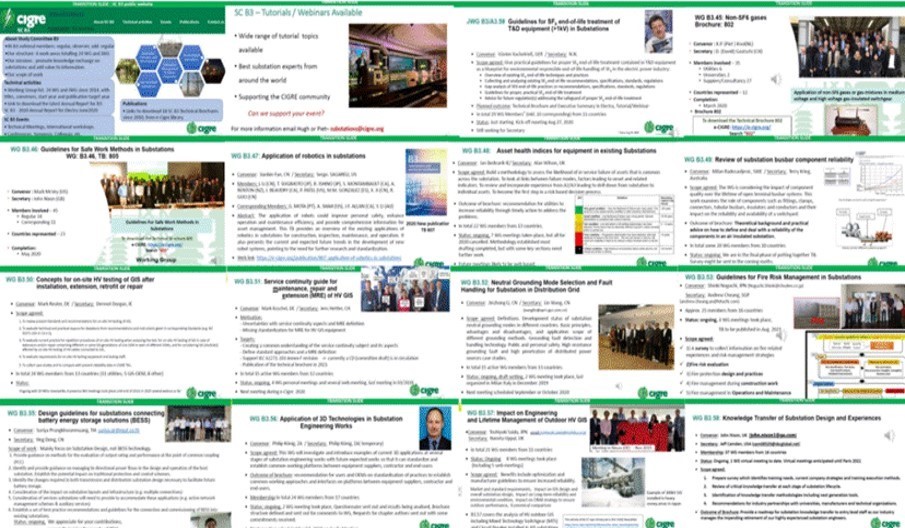
Figure 5 – Transition slides – B3 WG introduction
The Study Committee B3 annual meeting was held successfully over the Internet on 25th August. B3 welcomed 17 new B3 members approved in 2020. Anthony Giacomoni, Chair of NGN and Khayakazi Dioka, Chair of WiE were invited to the annual meeting to present each organisations activities and discuss with B3 members for mutual understanding.
The next annual meeting for Study Committee B3 will be held as a hybrid style meeting on 22nd August during the CIGRE Centennial Session.

Figure 6 – Study Committee B3 online annual meeting attendees
Events
Upcoming special events for the SC B3 include:
- Bucharest, Romania – 2021 CIGRE A2&B3 Joint Colloquium -11th -13th October 2021
- Ljubljana, Slovenia – 2021 Symposium - 21st -24th November 2021
- Foz do Iguaçu, Paraná, Brazil – X WORKSPOT - 21st -24th November 2021
- Vienna, Austria – CIGRE 3rd SEERC Conference - 29th November - 2nd December 2021
- Kyoto, Japan – 2022 Symposium - 3rd – 8th April 2022
Awards

CIGRE Technical Council Award
This award is granted to a few CIGRE Members as a reward for their active participation in the activities of the technical work of the Study Committees. In 2020, the award was delivered to Mark Osborne (UK) in recognition of his outstanding contributions to the life and work of the study committee. He has been the special reporter of the Group Discussion Meeting at CIGRE Paris Session since 2014 and B3 Area Advisor for substation concepts and development since 2007.

CIGRE NGN Significant Contribution Award
This award is intended to recognise the outstanding contributions of NGN members to CIGRE activities. In 2020, the award was delivered to Stefie Cray, the secretary of WG B3.41 Mobile Substations Incorporating HV GIS – Design Aspects. This award encourages other NGN members working under SC B3 activities.
CIGRE SC B3 Outstanding Service Award
The Outstanding Service Award of CIGRE SC B3 is granted by the SC Chair annually to two of its members in recognition of outstanding participation in and contribution to the SC's technical work. In 2020, this award was delivered to Alan Wilson (UK), John Randolph (US) and Romain Migne (FR).
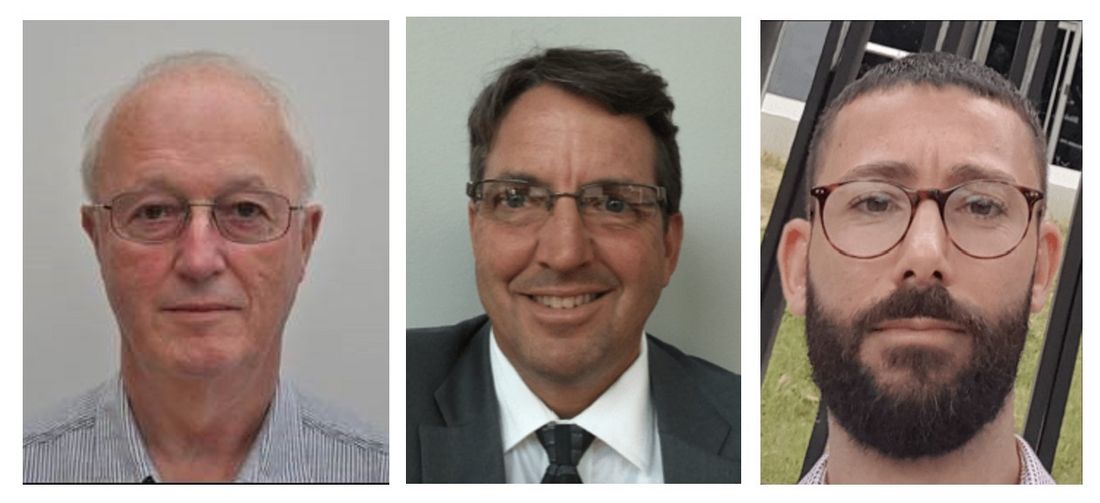
Alan Wilson, John Randolph and Romain Migné
Alan has participated in SC B3 Working Groups for more than 20 years and played many important roles such as sub-chapter leader of the Substation Greenbook, the tutorial tutor, and WG Secretary and member. He is presently the secretary of the WG B3.48 “Asset health indices for equipment in existing Substations”.
John served as SC B3 regular member from 2012 to 2018 and participated in B3 Working Groups. He is well known as the B3 popular reporter since 2015. Also, he is presently the Chair of the B3 Customer Advisory Group.
Romain participated in a lot of B3 Working Groups and the Secretary of the WG B3.32. He served as the SC B3 Secretary from 2014 to 2020, so he is one of the most popular members of SC B3.
Conclusions
As Chairperson, I am extremely grateful for the ongoing support of members and members’ organisations and our substation experts as we continue developing the future power network. SC B3 continues to keep an eye on the utility industry's rapid changes and works on new challenges with our experts for an environmentally friendly and sustainable future.
Finally, I wish all our members to stay safe and healthy, and I hope to see you all soon.
Check the Study Committee B3 website
